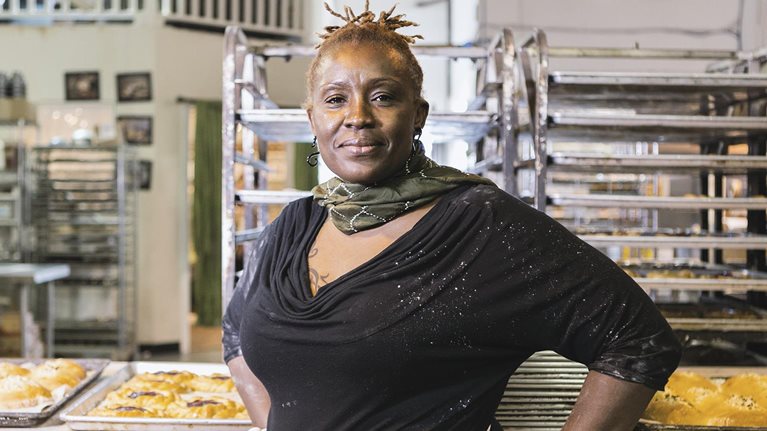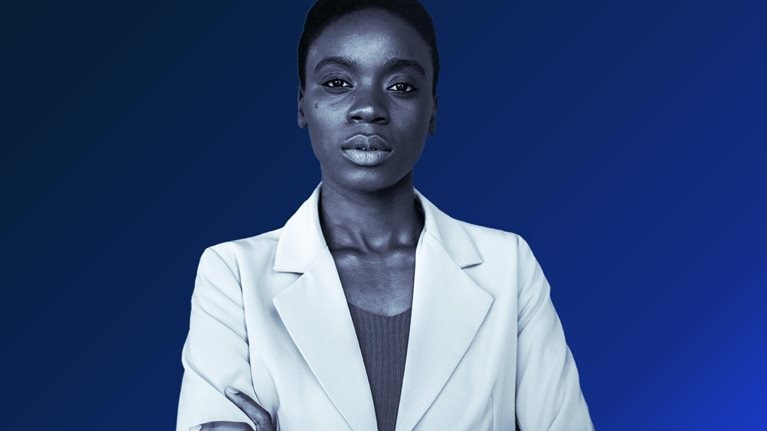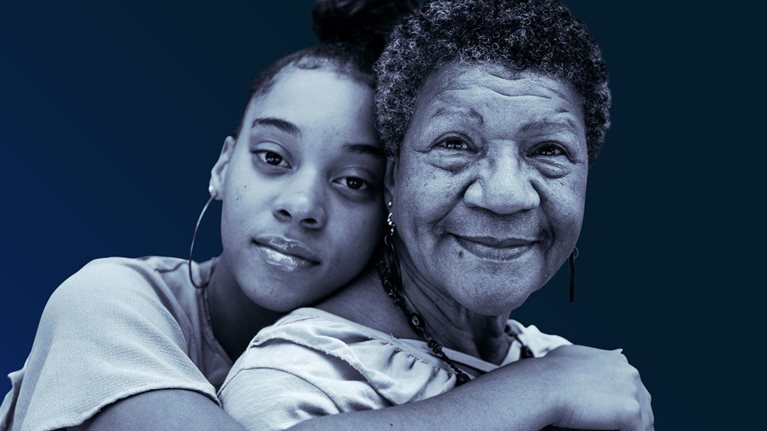In 2014, brothers Moses and Maurice Harris set out to build the kind of business they wanted to see in their rapidly gentrifying Los Angeles neighborhood—a locally owned, vibrantly designed space where everyone feels welcome.
Their business plan for Bloom & Plume Coffee combined Maurice’s vision as an artist and creator—he operates a successful floral-design business—and Moses’s skills in finance. They served their first cup of coffee in January 2019.
“We felt very strongly about creating a space of belonging,” Moses said. “We felt that with my brother being queer, and us being African American, we really wanted to create an intentional space where the community, our team members, and our products are really at the center of what we do.”
The road to opening Bloom & Plume was winding, starting with navigating the loan process. Even with Moses’s banking background and Maurice’s experience as an entrepreneur, the brothers were turned down by 35 to 40 traditional banks before securing a Small Business Association (SBA) loan through a local Black-owned community development financial institution (CDFI).
“The on-ramps into financial institutions—it’s like literally finding a needle in a haystack,” Moses said.
Despite having substantial collateral—the equity in a home owned by Moses covered the amount of the loan—and both having a steady income and business acumen, it was forming a relationship with a lender “who looked like him” that made the difference for Moses. They could not obtain a loan “until a Black-owned institution took the time to peel back the layer to really look at our loan package,” he said.
So, when California enacted a stay-at-home order in March 2020 due to the COVID-19 crisis, Moses knew exactly who to call.
With the help of their lender, they received a loan of approximately $26,000 through the federal Paycheck Protection Program (PPP). They used the funds to bring back the employees they had to furlough, and launched a delivery-service and e-commerce platform. Turning a spare bedroom in Maurice’s house into a makeshift warehouse, they packaged mugs and apparel embellished with Bloom & Plume’s signature “fist and flower” design.
Even with these new revenue streams, delivery and e-commerce sales failed to meet pre-COVID-19 pandemic revenue made from in-store customers. “It was really scary,” Moses said. “I sent an email to our lender, and I said, ‘If these days continue and the trend continues, we’re done. We’ll have to fold.’”
The COVID-19 crisis has forced millions of small-business owners to rethink their models or to switch gears completely. For Black-owned businesses like Bloom & Plume, preexisting inequities have been compounded by the economic crisis brought on by the pandemic. Even the increased attention on racial justice and equity came with challenges and introduced a different kind of uncertainty. The movement created surges in new business for proprietors like Moses and Maurice, along with questions about the sustainability of this new customer demand. All of these interwoven complexities illustrate the unique experience of Black business owners, historically and over the past year.
Unequal access to capital
Study after study has shown how the racial wealth gap and implicit bias have limited access to capital for Black entrepreneurs. Building the supporting ecosystems to mitigate the institutional barriers that lead to less access to capital and dimmer prospects for business growth by Black-owned businesses is not easy. Even when controlling for factors such as “firm characteristics and performance,” Black-owned businesses are still 20 percent less likely than white-owned businesses to obtain a loan from a large bank.1
These obstacles to creating strong relationships with financial institutions make it more difficult to navigate financial assistance, such as by acquiring a PPP loan. The federal-aid program offered $377 billion to small businesses in the early weeks of the COVID-19 crisis.2 Although it initially required business owners to go through a third-party lender, such as a bank or credit union, in May 2020 the SBA announced additional funding for CDFIs, like the one the Harris brothers partnered with, to provide PPP loans.3
“When you have something like this pandemic, it just comes and decimates these businesses because they were not adequately prepared to begin with,” said Fay Horwitt, CEO of Forward Cities, an economic-development nonprofit that helps produce more equitable entrepreneurial ecosystems.
“They may not even have the networks to get to the PPP application on time, even if they did have the proper information,” Horwitt said.
Like the Harris brothers at Bloom & Plume, many Black business owners we spoke with improvised and persevered as the pandemic continued. But experts say that any economic-recovery plan must acknowledge existing barriers to wealth, including the role that racial bias may play in banking.
“Normal wasn’t good for Black businesses before,” said Marc Philpart, managing director of PolicyLink, a national nonprofit focused on advancing racial and economic equity. “How do we rethink our approach? How can this experience during the pandemic be like a cocoon opportunity for us as a nation, so that we emerge in a way that allows for businesses to be on a different footing than they were before?”
A racial reckoning, followed by sudden growth and questions of sustainability
Small-business owner Dionna Dorsey knows how to survive economic uncertainty—it’s what led her to become an entrepreneur in the first place. As a young graphic designer, she survived several rounds of layoffs before eventually losing her office job in 2008. She started her first business, Dionna Dorsey Design, soon after.
“[I] couldn’t get hired, [so I] eventually just hired myself,” said Dorsey. In 2014, several years into building up her client roster for graphic-design work, she started her side business, the clothing brand District of Clothing.
Once the COVID-19 pandemic hit, her design company saw a 75 percent decline in client outreach. She then turned her attention to her online store, where she sells apparel with inspirational messages. The clothing brand soon became her main source of income.
The clothes carried messages—such as “Good Trouble Maker” in honor of the late civil-rights leader John Lewis. Following the death of Ahmaud Arbery, who was killed while jogging, and the subsequent police killings of Breonna Taylor, George Floyd, and other Black Americans, the message Dorsey had been pushing for years through her art found new resonance.
“These were the truths and beliefs, printed on apparel, that we’ve been projecting and presenting for almost six years. So, I think people just connect to authenticity, and I think people connect to truth. People connect to finding communities with like-minded people,” Dorsey said.
She received over 2,100 orders in 2020, compared with 267 orders in 2019—a nearly 680 percent increase year over year.
Bloom & Plume Coffee also saw a surge in sales in its store after the murder of George Floyd. As social-media users launched #BlackOutTuesday, the Harris brothers were overwhelmed by the amount of orders they received, as they were still learning how to sustain an e-commerce business. “Hypergrowth like that is really unsustainable, and it’s really hard on our bodies. We didn’t have [the] infrastructure for that. We weren’t prepared. Our vendors weren’t prepared,” said Moses Harris.
Dr. Kristian Edwards, the founder of BLK + GRN, a marketplace for Black-owned all-natural personal-care products, also saw a surge in business during the rise of the Black Lives Matter movement.
“We historically always had Black female customers; that’s been our demographic,” she said. “After all this stuff happened with police murdering Black people, I think that white people made a choice to try to buy Black [and said], ‘I want to support a Black brand.’”
Edwards questioned the timing and staying power of her new customers. “It makes me kind of frustrated because why did it take something so negative for you to want to be supportive?”
Seventy-five percent of Black-owned businesses reported an uptick in sales during the summer.4 But as public support for the Black Lives Matter movement began to wane, business owners like the Harris brothers saw sales level off.5
“By that time, the wave settled down and Black lives weren’t really that important anymore,” said Moses Harris.
Options to help decrease the barriers Black-business owners face
These two crises—COVID-19 and America’s own reckoning with systemic racism—can also be an opportunity to address long-standing structural inequalities. Government and public- and private-sector leaders are well advised to focus on the following three key areas to address the social and economic barriers Black owners face when opening and growing their businesses:
- Help provide equal access to capital
- Enhance communication tactics
- Expand opportunities for financial education and networks
To help provide Black-owned businesses with equal opportunities when applying for loans, banks can do their part to eliminate racial biases within the loan process—for both business loans and mortgages.6 Banking institutions can reassess their lending standards—for example, by providing more opportunities for borrowers online and removing requirements for in-person transactions that could unintentionally create room for racial bias to enter the process. Banks can also take measures to be more transparent so that borrowers have more insight into each step of the loan process.7
In the short term, larger corporations can offer emergency grants to struggling businesses, while governmental agencies, such as the SBA, can encourage investors to practice greater inclusivity across their boards. In the long term, banking institutions can use AI to make the loan process more fair instead of relying solely on human judgment.8 When using AI, however, banks are well advised to watch for algorithms that could potentially produce biased outcomes.
Financial institutions can ultimately make the process of getting financial assistance more user-friendly. Many small Black businesses may lack access to the resources and tools needed to apply for loans and financial support offered by the government and private sector. For instance, some small businesses were less open to applying for a PPP loan due to a lack of clarification and consistency around navigating the forgiveness portion of the program and understanding the changes to the SBA guidance.9Governmental agencies, nonprofit organizations, and the private sector can review their outreach programs and educational campaigns to increase awareness of existing resources and ultimately make them more accessible to all.
Studies have found that business owners with higher levels of business and financial education are more likely to also see higher sales, profits, and survival rates.10 The private and social sectors—particularly anchor institutions such as universities—could offer educational resources aimed at business owners and their employees. With more education and training, small businesses can develop skills in accounting, business planning, and general management to spark growth or stay afloat during an economic crisis.
Black-owned businesses also tend to lack access to a supportive network—of both banking institutions and more seasoned business owners—that can help them navigate each stage of their business journey, including the process of obtaining loans and grants. Black-owned businesses tend to have a weaker relationship with banking institutions, which can affect their access to loans: fewer than one in four Black-owned employer firms reported having a recent borrowing relationship with a bank.11 Banking institutions can build up relationships with Black-owned businesses to broaden the businesses’ connection to financial needs.
Although a strong business network is typically created organically, federal, state, and local governments can help foster these relationships with partnerships and launch initiatives at a larger scale.12 Larger companies can also play a role in creating peer-to-peer connections with smaller businesses through mentorship.
Despite systemic inequities, a potentially longer road to post-COVID-19 recovery, and the complexities of being viewed by customers in the context of racial justice, Black business owners remain hopeful and are looking for ways to create and sustain momentum.
For the Harris brothers, they continue to find ways to infuse their creative spirit into their brand. Maurice is featured as a judge on Full Bloom, a new floral-design-competition reality show—a promising and unique way to catch the attention of new fans.
“I feel like I don’t have a choice but to push through, to continue to fight and keep hope alive,” said Moses Harris. “In our family, we always talk about the famous Black mantra, ‘This too shall pass.’ It really gets into the fabric of the essence of Blackness in America. There’s just this deep resilience to keep on going. Keep on going and don’t ever quit.”


